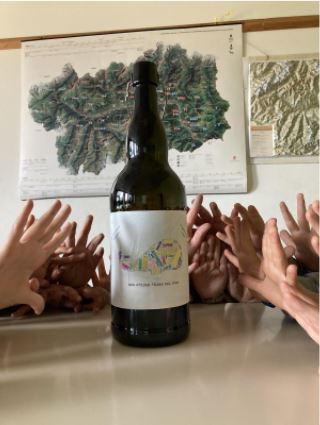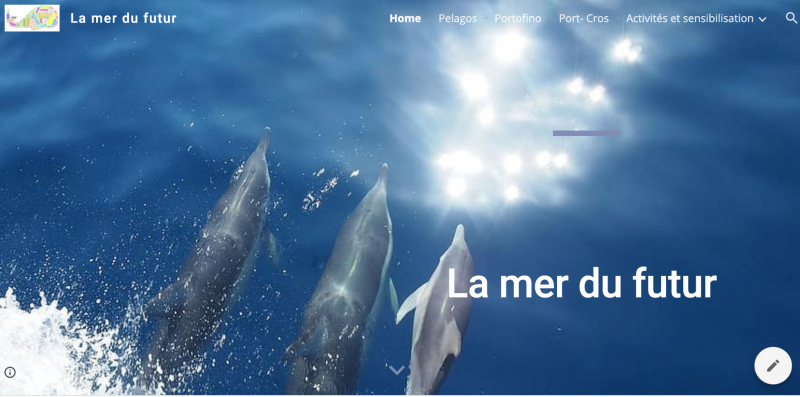Author: class III A, I.S. Abbé Trèves - St. Vincent, Valle d’Aosta (IT)
PARTNER: class III B I.S. Abbé Trèves - St. Vincent, Valle d’Aosta (IT);
classe V IC Bosco Chiesanuova, Corbiolo, Verona (IT)
Introduction

Les élèves et la capsule temporelle
Our class aims to inform the partners about "The Sanctuary of Pelagos", a maritime area subject to an Agreement between Italy, the Principality of Monaco and France for the protection of the marine mammals living there and how biodiversity, within this subunit of the Large-Scale Marine Ecosystem of the Mediterranean, suffers the impacts of human activities.
Learning Objectives
- Key competences for citizenship (EU)
- knowledge and cultural expression: learn how to learn
- Communicate across multiple languages
- Civic education - acquiring information and developing a critical mind on the themes of environmental education: Know the main rules of behaviour and respect in order to protect natural environments
- Geography -identify and distinguish transformations in the natural and anthropogenic landscape
- Science - understanding current scientific problems and adopting responsible behaviours: Know the marine ecosystem and the behaviours to adopt to preserve it
- Language - produce multilingual texts of different types according to different communication objectives
- Technology - use the most common technologies by identifying potentially useful solutions to a given application context from the study activity
Task

La mer du futur: cover of website created by the pupils
- Research of information on the "Pelagos Sanctuary" (first cross-border marine area) and on the two partners of the convention "Port - Cros National Park" and "Portofino Regional Natural Park"
- Drafting of the Seedquest and creation of posters
- Identification of risks and problems related to the protection of the coastal heritage
- Research of solutions/strategies to preserve the coastal heritage
- Preparation of a multimedia product (mini website) to share our discoveries with our friends in Corbiolo
- "Time capsule", bottled message for 2030
Process
To accomplish the task, the work will be divided into several phases:
1. Understand that a mini website is built within digital hardware
- locate where to find information
- learn how to select and save links
This phase will is conducted by teachers with the whole class using an integrated educational approach. It provides for the use of the interactive whiteboard and the guided navigation within the selection of web sites
2. The class is divided into study groups and sub-groups (Pelagos - Portofino - Port-Cros) that will refer to the resources and documents provided by teachers for:
- searching for information regarding "The Sanctuary of Pelagos", "Port - Cros National Park" and "Portofino Regional Park"
- to seek out and understand the behaviours that we must adopt in order to preserve the coastal heritage
- identify the risks associated with each marine protected area
This phase takes place in the computer room where each child uses the computer for guided navigation between the sites provided by the teachers and in class with the interactive whiteboard. Each group will bring the information they have found.
3. Learn how to make a minisite
This phase is be conducted by teachers with the whole class using an integrated educational approach. It allows each child to use the computer to enter the information found by their own group and the use of the interactive whiteboard with the whole class to search the general information.
4. Creation of the mini website
Group work: in a coordinated action by teachers, the various groups participatein the design and production of multimedia according to the tasks assigned.
The mini web site includes the following sections:
- a cover with the title of the activity and the class it is involved
- a menu of topics covered
- the themes:
- coastal heritage in the Pelagos area, Port-Cros and Portofino
- protection of the ecosystem - small description of the flora and fauna
- what behaviours we must adopt to preserve this heritage and how we can "enjoy" marine areas whilst respecting biodiversity
- ongoing activities to document the work
- our friends from Corbiolo: work carried out by the twinned class
5. Creation of messages for awareness to keep in the time capsule: individual work
As search engines for children have been used:
- wikimini.org (L2)
- safesearchkids.com
- qwantjunior.co
Other links:
- Port-Cros National Park https://www.youtube.com/watch?v=PdR8o1IVgVk
- Portofino Regional Natural Park https://youtu.be/ELcpSJuFkvc
Evaluation
- Describing the importance of the sea and the role of the marine protected area
- Knowing and understanding the importance of prohibitions and codes of conduct
- Name and recognise at least three protected species
- Knowing the main threats to protected species
- Teamwork
- Understanding the importance of effective communication
- Developing an information and awareness website for the Pelagos area
- Using simple digital materials for learning
- Sharing acquired information
- Raising awareness of the many issues related to biodiversity
- Understand that our actions and behaviours can preserve and contribute to the development of environmental protection
- Use the most common technologies in concrete communication context
- Evaluative technologies, scientific knowledge, computer knowledge and social skills
- Teacher observation and compilation of development assessment headings
- Self-assessment
Conclusion
When we present the work to our fellow pupils we will reflect on the activity and how it was.
Here are some questions:
- Do you think that this activity has increased your geographical and scientific knowledge?
- Are you going to look at nature in a different way?
- Do you think what you have learned can be used in other contexts?
Teachers Section
- Decide to reflect on environmental issues
- Define the initial situation (starting point, initial knowledge)
- Imagining a desirable future situation
- Taking action: carrying out the task or the final product
- Evaluate and share the project
Teacher Links:
Different steps in teaching
https://drive.google.com/file/d/1Z2Y6MwtlfeJLMDJXZ4U4Eo84qRihPIDU/view?usp=sharing










